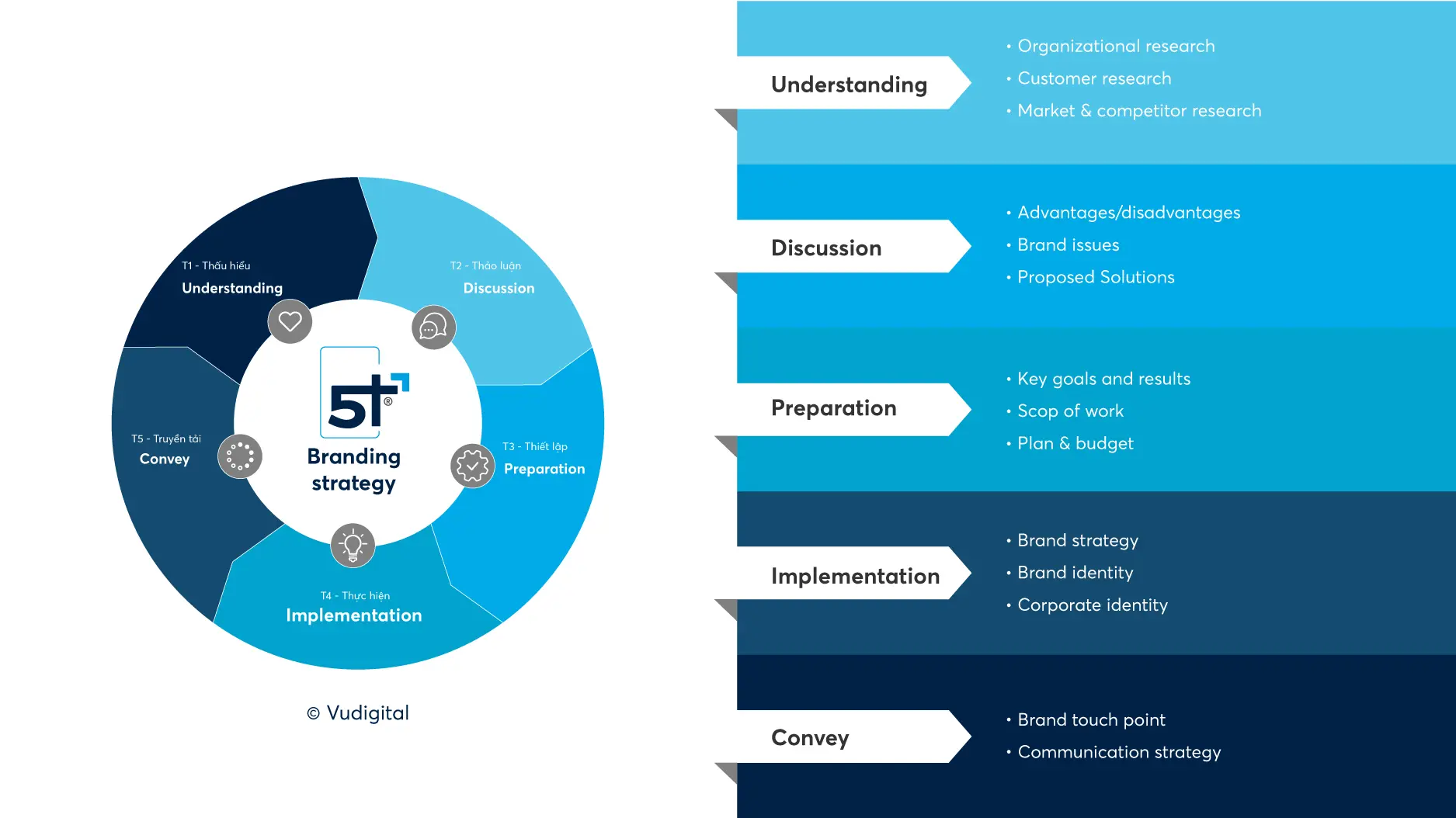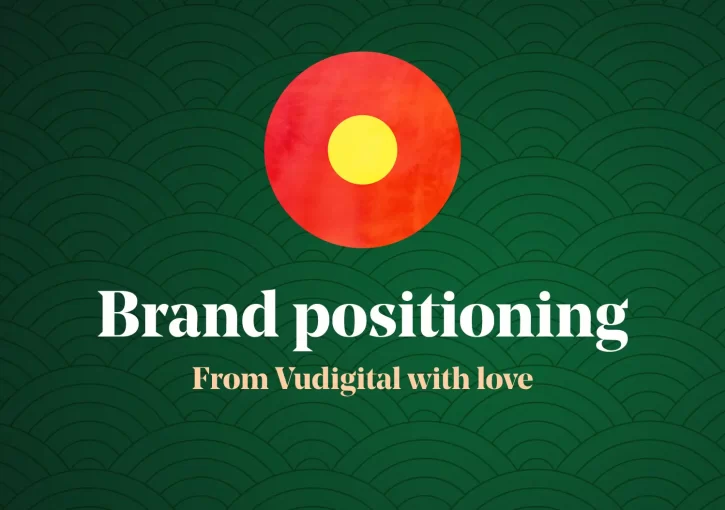Brand strategy is a group of solutions, guidelines, and plans to affirm the brand’s unique position in customers’ minds. However, it does not exceed the available resources of the business.

5T Model © Vu Digital.
Jessica Walsh – the co-founder of Sagmeister & Walsh, a famous design agency that has worked with Levi’s and Adobe – once said:
If no one hates it, no one really loves it.
Vu’s team entirely agrees with this point of view and, at the same time, affirms that this is the idea that every brand team needs to memorize.
Branding is more than just giving your company an ideal appearance through a polished brand identity design.
It is not about winning customers’ trust with commitments, statements, or promises that do not match the reality of the team’s capacity.
An effective brand strategy guarantees all three factors: matching team capacity, maintaining competitiveness, and winning trust.
Therefore, building a brand strategy has never been a simple story. Brand strategy is not “I already have a logo design. What else do I need” or “Tell me how much it costs to build a brand strategy.” When building a brand strategy, please don’t rush to cost, schedule, or process.
In our articles or during meetings with our clients, Vu always mentions the word “effective,” We want to use it as the final destination of every brand building and development campaign.
However, relevancy is the most critical factor in building a compelling brand strategy. Relevancy is the degree of concordance between business leaders & brand consultants and the concordance between the business orientation & market approaches.
Are you confused? Don’t worry because Vu was once extremely confused about finding a solution to achieve the mentioned effectiveness. There must be a plan, system, or even a visual model, which helps to concretize further the standard, methodical, scientific brand strategy-building process.
It motivates Vu’s team to create the 5T model – a model to build a standard brand strategy. This model helps us understand the positive values a heritage brand can own.
We will talk about this model later. First, let’s analyze the definitions of brand strategy.
The essence of strategy is to choose what not to do.
– Michael E. Porter –
What is brand strategy? Brand strategy versus Brand tactics
We use brand strategy to accomplish specific goals. Strategy is not a guarantee; it is just a method for a brand to reach ultimate success.
Therefore, it is necessary to involve multiple different brand tactics to create more opportunities and increase the probability of success of any brand strategy.
The correlation between brand strategy and tactics is the same as the relationship between brand vision and mission mentioned in many articles.
If “vision” represents the long-term goals and directions of the brand, then the mission defines what the brand will do to realize those goals.
Take the example of the epidemic prevention and control of Ho Chi Minh City in 2021.
From October 1, 2021, the government’s epidemic prevention strategy is to bring life back to the “new normal.” It combines epidemic prevention with step-by-step recovery and economic improvement.
With this strategy, the city government has proposed and deployed many tactics. They include vaccination coverage for more than 80% of the population, Covid green card usage in traveling, improvements in managing F0 self-treatment at home, …
Medical and any business on the way to success in strategy need to research and deploy many different tactics.
Of course, we don’t have to be successful with every strategy we pursue, and there’s a minimal chance it will happen. We use various brand tactics to increase the success of our brand strategy.
Besides, using multiple tactics is a way to evaluate the effectiveness and potential of each separately. We can allocate the budget to the right tactics, reduce opportunity costs, and simultaneously bring the success potential of the brand strategy to its fullest.
Many Vietnamese enterprises make an inherent mistake when building and implementing brand strategy. They try to create one tactic corresponding to one brand strategy. Furthermore, they confuse the two concepts and then lose the practical value that brand tactics and strategy bring.
Turn your brand strategy into a story
When someone asks Vu about the difference between “branding” and “marketing,” we always answer that the difference lies in the role of each term.
The essential task of “branding” is to build awareness and strengthen the level of trust with an effective brand strategy. Marketers are those who follow that achievement with the task of taking care of and building good relationships with customers. It helps customers believe and return to the brand and motivate them to contribute directly to the revenue and profit of the business.
Storytelling will captivate customers intuitively.

Jessica Walsh (Source: nytimes.com)
So back to Jessica Walsh’s famous quote at the beginning of the article: “If no one hates it, no one really loves it.” Branding and brand strategy development begins when consumers have no brand awareness.
What will convince them to find, recognize, be aware and then stick with a brand while they do not have the opportunity to experience the brand’s products?
The answer lies in consumer intuition. Instead of bombarding them with fancy hype and promises, we should gently convince our customers’ instincts – by turning the brand strategy into a story.
If a brand strategy is a story, then business leaders must be storytellers who incorporate the problems and worries and emphasize the customers’ needs.
Imagine that process as making a movie. The directors always create antitheses, pushing the character’s psychology to the climax.
Antithesis from contemporary art and cinema
Let’s take an example of superhero movies. The main character is originally an average person living in the middle of nowhere, just like us.
When the opportunity to become a superhero comes, they often deny this power and mission at the film’s beginning.
They believe that what is happening is what should happen. There is no intention for those characters to change reality.
At this point, the screenwriter will insert an antithesis to create a knot for the whole story.
An “antithesis” is a situation pulling the main character out of reality to make them believe that choosing to be a superhero is the righteous path they should follow.

Spider-man and his uncle Ben (Source: Marvel.com)
In the Spider-Man series from Marvel, the Spider-Man character in the early days used his superpowers to make money.
One evening, he was happy with the money he had just earned and decided to spare a roadside robber.
A few seconds later, the robber accidentally pulled the trigger while escaping to kill Ben – the uncle that Spider-Man has loved the most since childhood.
This scene is an antithesis made up by the screenwriter. It will torment Spider-Man for the rest of his life because he can use his superpower to make money, but he can’t use that superpower to save his beloved uncle.
Then, Spider-man accepted the “heaven-given” superpower with a more willing attitude.
He uses it to eliminate evil and bring peace to those around him. It is also a way for him to memorize and apologize to his uncle.
What does the antithesis have to do with brand strategy?

Dionysus, Athens, Greece (Source: Shutterstock)
Ancient Greeks used antithesis as the foundation of their storytelling long ago. They repeatedly used this technique in plays that took place at the theater of Dionysus in the early fifth century, before we widely applied antithesis in modern art and cinema.
If you notice, you will find that the big brands also use the antithesis technique quite often.
The antithesis of brand strategy is telling consumers what their problem is and how the brand’s products solve that problem and improve their lives.
Take Apple and Volvo as examples. Apple confidently announced to the public that customers could use their products immediately after purchasing. Volvo pledges that no one will die from serious injuries as long as they drive a Volvo car.
That’s how Apple, Volvo, or thousands of other big brands use antithesis to inspire consumers. They implied that by owning their products or services, customers are helping to make the world a better place.
Building brand strategy with the 5T model

Howard Schultz (Source: Starbucks)
Howard Schultz – the former CEO of Starbucks, once commented:
If people believe they share values with a company, they will stay loyal to the brand.
Schultz has lived with this philosophy for years. Besides pursuing environmental protection plans and investing resources to make each store an actual enjoyment space, Starbucks fully respects human rights. It pushes team values in the company to a new level.

Patricia Marques (Source: baodautu.vn)
When asked about the criteria one needs to become an employee, Ms. Patricia Marques – General Director of Starbucks Vietnam, said:
If you don’t like getting up early, working on the weekends, and treating everyone and customers equally, very soon, you will feel lost during our team and want to leave.
In return, becoming a Starbucks employee in any position is an experience and a memorable time everyone should try once in their life.
When Ho Chi Minh City and Hanoi were heavily affected by the pandemic, Marques also affirmed: “We do not want to lose anyone in this moment. Whomever they are, and whatever position they are in, my biggest job is to make sure people don’t lose their jobs.”
We do not hide the idea that leading brands, such as Apple, Starbucks, or Volvo, are the inspiration in the work of our team.
It is also a motivation and an endless source of knowledge for us to invest and introduce the 5T model – an application tool to build a compelling brand strategy – which Vu collected and developed to share with the public.
T1 – Thấu hiểu (Understanding)

Vu Digital’s team discusses during the Understanding phase.
According to statistics from Teradata, only 41% of global marketing executives accept using user interaction data to understand the needs and accurately inform customers about the following campaigns.
It is an alarming statistic about brands’ ability to empathize and understand customer needs.
They were going against the goal of empathizing with customers. Many brands are still creating products they think are suitable for themselves instead of those that serve as an antithesis, similar to what Vu has just shared above. Antithesis products would help motivate customers to trust, purchase, and use, believing that they contribute to making the world a better place.
Besides understanding customers, business leaders must understand their team, market, and competitors.
Before developing an effective brand strategy, you need to be an effective business leader.
We should approach the market with an affirmative, honest, customer-oriented mind. An effective brand strategy starts from here.
T2 – Thảo luận (Discussion)

Vu Digital’s team discusses with our clients
When asked about the telltale signs of a strong brand, Mr. Lee Frederiksen – Doctor of Behavioral Psychology and author of Inside The Buyer’s Brain, commented:
A professional services brand is made up of two elements, your firm’s reputation and its visibility.
“If you have an excellent reputation widely known within the target audience, you have a strong brand.”
“Usually, each individual in the business is only interested in whether he has completed the task or not. Instead of worrying about weaknesses or problems they cannot solve well.”
It is also one of the biggest concerns for Vu when searching and applying the 5T model.
Many businesses still struggle in the “matrix” of their advantages when building their brand strategy. They rest on their laurels instead of discussing and pointing out the flaws and many other shortcomings.
We should remember that customers judge our brands based on their perceptions. They don’t care whether they have much experience or knowledge in your industry.
Don’t waste time repeatedly replacing your executives and hoping everything will improve; sit down and discuss your team’s strengths and weaknesses. We should correctly determine the advantages and disadvantages from individual to cooperative, find out the real problems, and then come up with a proposal with multiple solutions.
T3 – Thiết lập (Preparation)

Vu Digital’s team are setting goals and final results
Professor Phan Van Truong – International Trade Advisor to the French Government, has shared:
The director in a company is not the boss but the one who seeks optimal solutions to solve the company’s problems.
“If none of the 20 bosses in a large team can find the optimal solution, but another junior employee found it, the junior was the actual leader.”
So what is the foundation of an optimal solution in brand strategy? Vu’s team believes it is about setting goals and planning appropriate implementation.
For instance, many leaders will focus on goals such as customer satisfaction while approaching brand strategy. They aim to make the brand name appear densely in the media regardless of the quality of the return.
To our team, we don’t approach the projects in the way they did. In contrast, we look for effectiveness in each brand strategy we develop. And so, there will be a little difference in setting goals and planning to build a brand strategy.
More than just satisfying, Vu will make your customers want to tell everyone about that satisfaction.
More than just putting your brand name on media, Vu will make your customers actively form an excellent perception of your brand.
To us, it is the highest success in all brand plans and modern strategies.
T4 – Thực hiện (Implementation)

Vu Digital’s team working on identity building and strategic design, and brand identity.
According to statistics from PwC in 2018, 63% of customers said they are willing to share their data and information, provided that the brand proves to create good values for the community.
In the same year, 59% of consumers said they would immediately boycott if they had terrible brand experiences after only one or two times.
These metrics demonstrate the importance of cognitive factors – both emotional and rational – that an effective brand strategy conveys.
Many managers and business executives often make a common mistake: focusing too much on consumers’ emotional or rational perceptions in building a brand strategy, not both.
Some always believe that product quality is all it takes to build a brand strategy.
Others believe attracting consumers’ emotions with emotional perception elements is the only path every brand team should follow.
Meanwhile, according to the market research firm Yankelovich, each person has the chance to access more than 5,000 different advertising messages in just 24 hours.
It means a brand has less than 7 seconds to complete the task of winning customers’ minds in terms of brand awareness.
Of course, it must result from a methodical, scientific, and well-coordinated implementation plan between cognitive and emotional factors.
It is also the perfect combination of brand strategy, brand identity, and elements closely related to culture and brand identity.
T5 – Truyền tải (Convey)

Vu Digital’s team analyzes brand touchpoints
You don’t want to turn your brand strategy into a heartless machine, which means operating mechanically without letting brand values be associated with good culture and values.
It is the reason for the birth of “Brand Touchpoint,” which has continuously been researched and applied by thousands of brands globally.
To become a model in spreading good values, a brand must first put itself in the position of consumers at least once.
Brand strategy orientation closely follows the point of view and perspective of valid customers. What do they think of a trusted brand? How do they feel about your brand? Do they choose to find you for some reason?
Like the person who chose to purchase a BMW car because of the love of the driving experience, they certainly don’t mind sitting in the back seat, enjoying the prestigious feeling of a Mercedes Benz S-Class.
Apple customers, who love the minimal luxury of the iPhone, cannot be persuaded by the sophisticated designs or ahead-of-time technologies of Android smartphones.
The “exclusive experiences” that Apple, BMW, or many other big brands own are positive touchpoints that cannot be absent in brand strategies.
Exclusive experiences also convey outstanding brand values and strengths to the audiences. Brands can now stop trying to visualize value with clichés messages that are only useful for short-term brands.
Be proactive in building brand touchpoints and integrating them into your brand strategy. They serve as a solid foundation and a firm promise that your brand will never betray the “exclusive experiences” and never let the customers down.
Conclusion
We certainly don’t want to; even if we do, we can’t change the short-term brands’ views immediately because many leaders decide to follow authoritarian beliefs.
However, if you are confident that your team operates and pursues positive values with your products or services, but are still struggling to develop brand strategies, then you find us.
To understand the world of branding and strengthen your knowledge of brand & brand design, you can connect with Vu through the links below:
- Website: https://vudigital.co/
- Fanpage: https://www.facebook.com/vudigital.co
- Instagram: https://www.instagram.com/vu.digital/
- Behance: https://www.behance.net/vu-digital
- LinkedIn: https://vn.linkedin.com/in/vudigital
Sincerely,
Common Questions
What is brand strategy?
Brand strategy is a group of solutions, guidelines, and plans to affirm the brand's unique position in customers' minds. However, it does not exceed the available resources of the business.
What is 5T brand strategy model?
T1 – Thấu hiểu (Understanding)
T2 – Thảo luận (Discussion)
T3 – Thiết lập (Preparation)
T4 – Thực hiện (Implementation)
T5 – Truyền tải (Convey)
Who created the 5T brand strategy model?
The 5T brand strategy model is created and developed by Quyen Vu - founder of Vu Digital
What is the most important part in brand strategy?
The most important part of a brand strategy is to determine the target customer's perception that the business wants to achieve.
Should I build a brand strategy myself?
Suppose you decide to build a brand strategy yourself. In that case, the time and opportunity costs will be extremely high, so I recommend looking for professional and experienced teams with scientific methodologies and models. Consider the money spent when building a brand strategy as an investment. We believe it is the most profitable investment for you in the future. All the data generated in building a brand strategy is brand assets, which would be transmitted to customers, and converted into future profits. - Quyen Vu -












